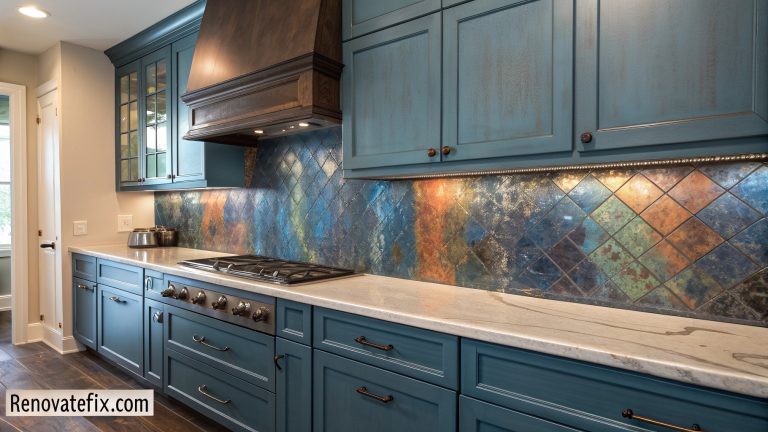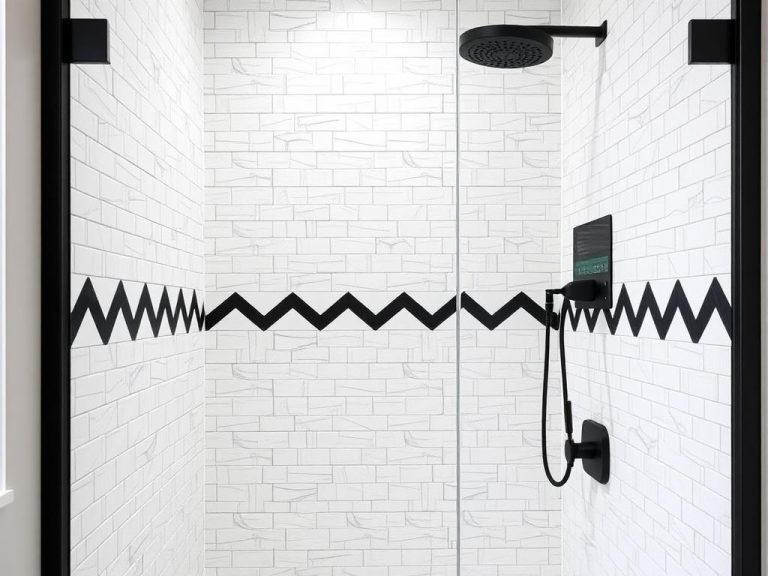Outdoor Mud Kitchen Ideas for Creative Play
Outdoor mud kitchens offer children an exciting way to engage with nature while developing essential sensory and cognitive skills.
These play spaces combine natural elements with imaginative cooking scenarios, allowing kids to experiment, create, and explore in an unstructured environment.
Whether you have a spacious backyard or a compact patio area, these mud kitchen concepts can be adapted to fit your space and budget.
From simple DIY setups using reclaimed materials to more elaborate constructions with multiple features, there’s a mud kitchen idea perfect for every family’s needs.
Let’s explore twenty inspiring mud kitchen ideas that will bring hours of messy, educational fun to your outdoor play area.
15 Inspiring Mud Kitchen Ideas
1. Pallet Perfection Mud Kitchen
Repurpose old wooden pallets into a charming rustic cooking station where little chefs can mix mud pies and concoct nature potions.
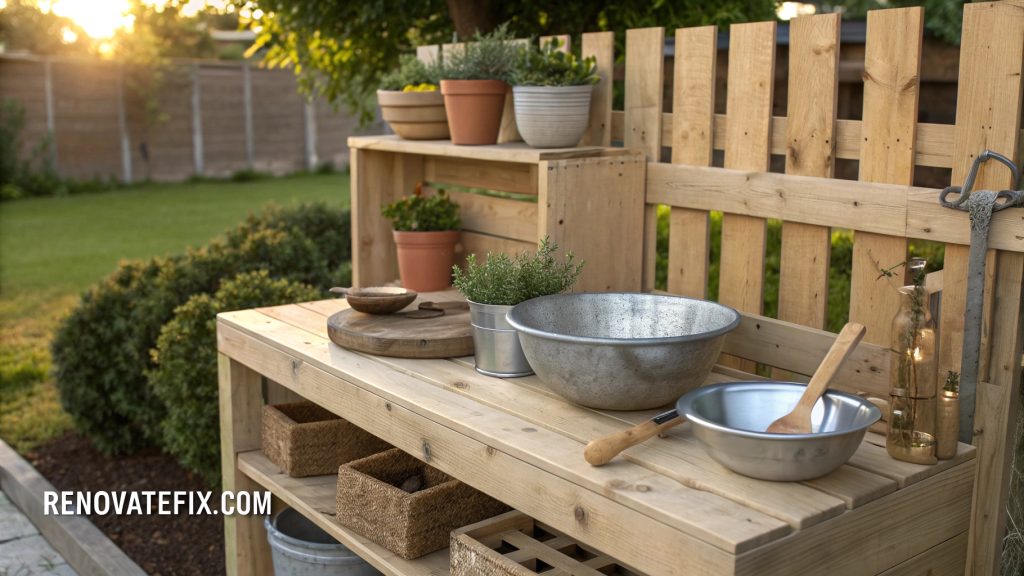
Add simple metal bowls, wooden spoons, and plant pots to create an inviting space that encourages hours of imaginative play outdoors while connecting children with natural materials and sustainable building practices.
2. Corner Nook Mud Kitchen
Maximize unused yard space by building an L-shaped cooking area nestled into a garden corner, providing multiple work surfaces for collaborative play among siblings or friends.

Outfit this cozy culinary corner with hanging utensils, shelving for nature ingredients, and perhaps a small roof overhang to extend play possibilities even during light rain showers.
3. Upcycled Sink Mud Kitchen
Mount an old bathroom or kitchen sink into a sturdy wooden frame to create a functional water feature that allows children to pump, pour, and mix with actual flowing water.
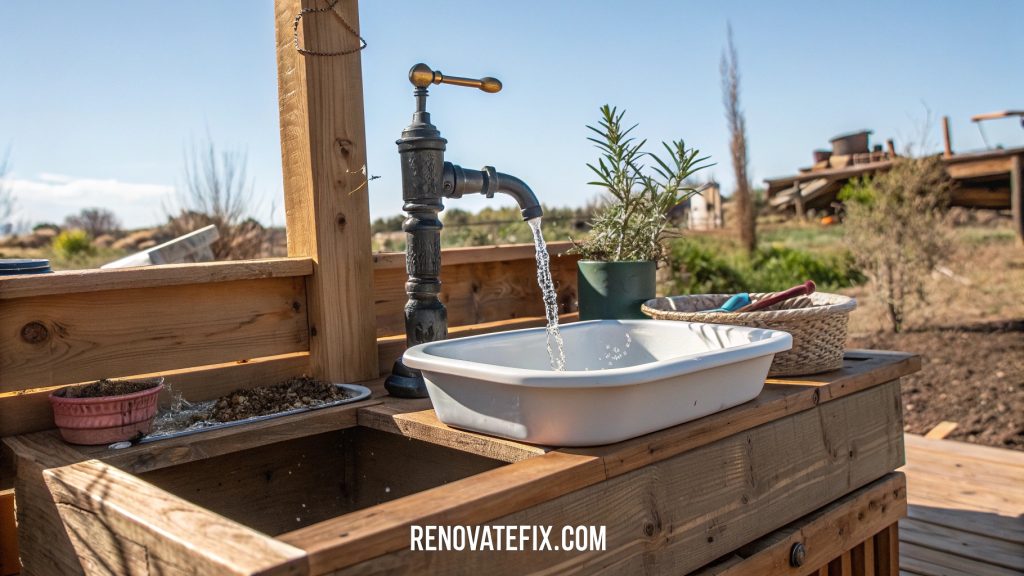
Position a large bucket underneath to catch runoff, creating an eco-friendly system that combines water and earth play while teaching youngsters about conservation and the properties of different materials.
4. Musical Mud Kitchen
Attach pots, pans, and metal utensils to your cooking station to create a dual-purpose play area where children can drum, tap, and create rhythmic sounds while they cook up mud delicacies.
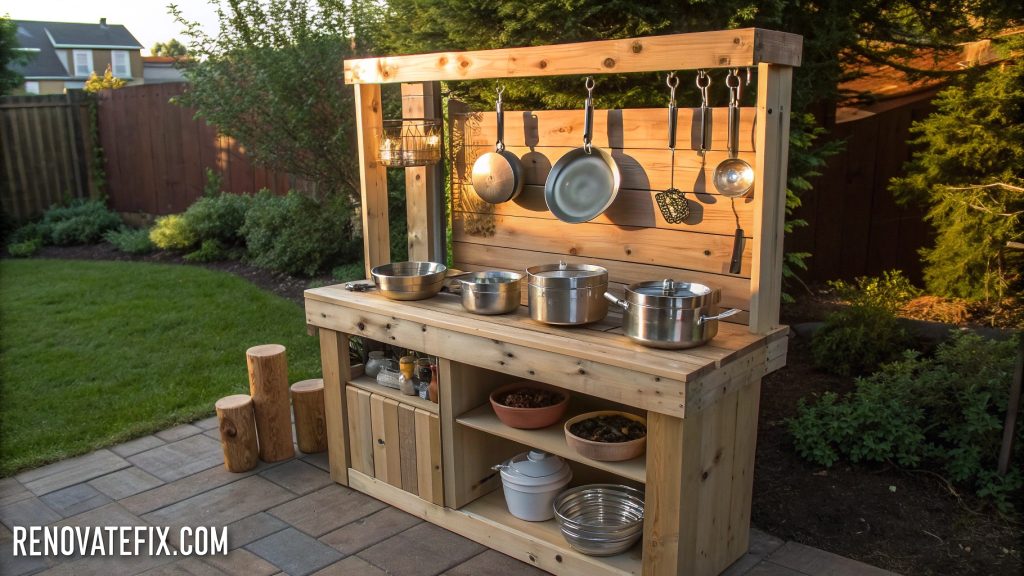
Hang these sound-making implements at different heights using strong cord or hooks, encouraging both culinary creativity and musical expression in one dynamic outdoor play space.
5. Rolling Cart Mud Kitchen
Convert an old bar cart or rolling kitchen island into a mobile cooking station that can be moved around the yard to follow shade or sun according to weather conditions.
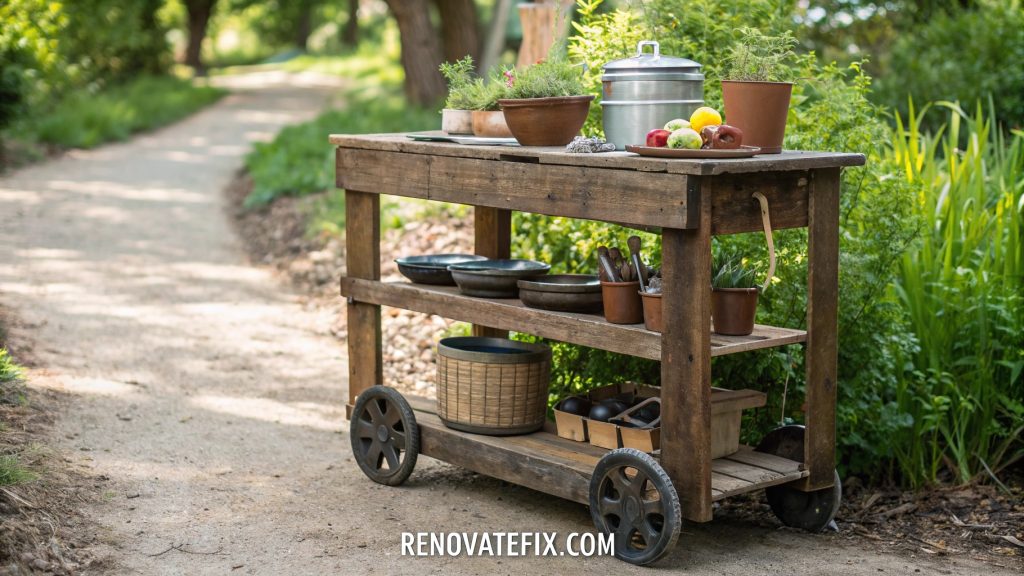
Equip with sturdy wheels that lock in place, adjustable shelving, and perhaps a removable tray top for gathering natural materials during foraging expeditions around the garden.
6. Chalkboard Menu Mud Kitchen
Add a weather-resistant chalkboard panel to your setup where budding chefs can write daily specials, draw ingredient lists, or practice writing skills while planning their mud cuisine.
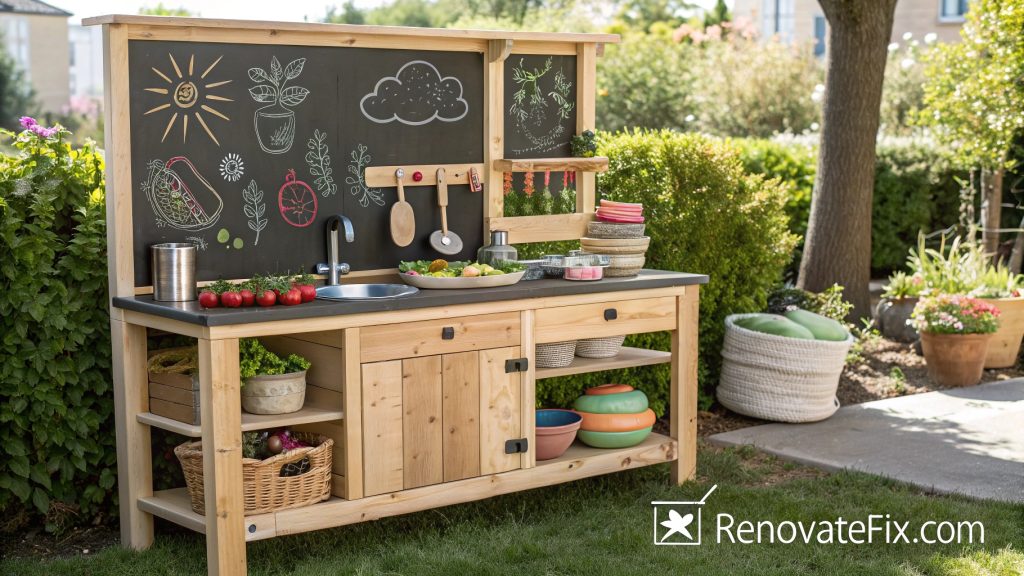
Mount this dark surface at child height, provide outdoor chalk in various colors, and watch as literacy naturally blends with sensory play in this educational cooking environment.
7. Mini-Greenhouse Mud Kitchen
Combine gardening with culinary play by attaching a small clear plastic or glass-paneled growing area above the cooking station where children can nurture real herbs or flowers for use in their mud recipes.
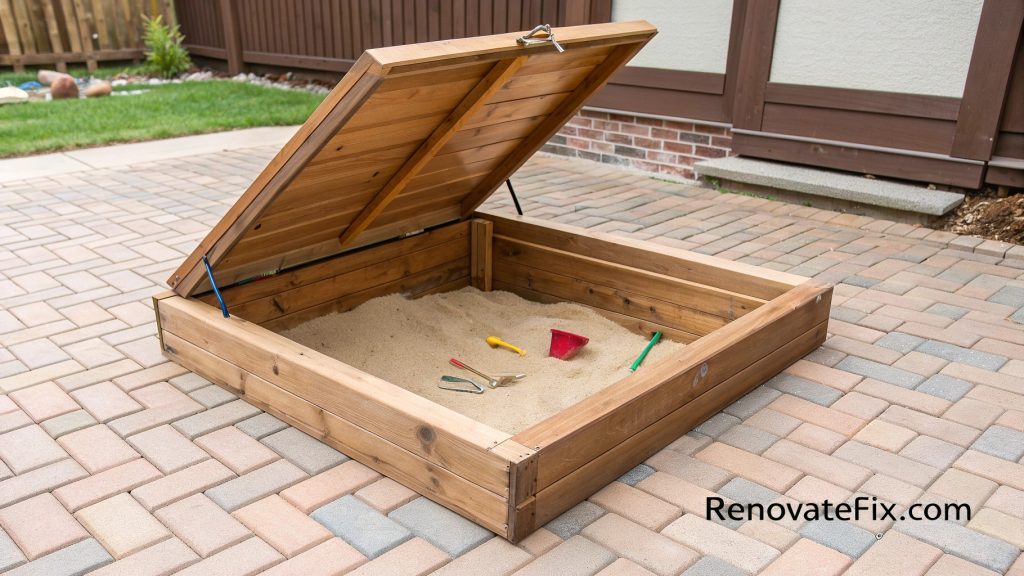
This thoughtful addition connects food preparation play with actual plant growth, teaching life cycles while enhancing sensory experiences with fresh botanical scents.
8. Log Ring Mud Kitchen
Arrange thick tree stumps of varying heights in a semi-circle to create natural seating and work surfaces perfect for collaborative outdoor cooking adventures among friends.
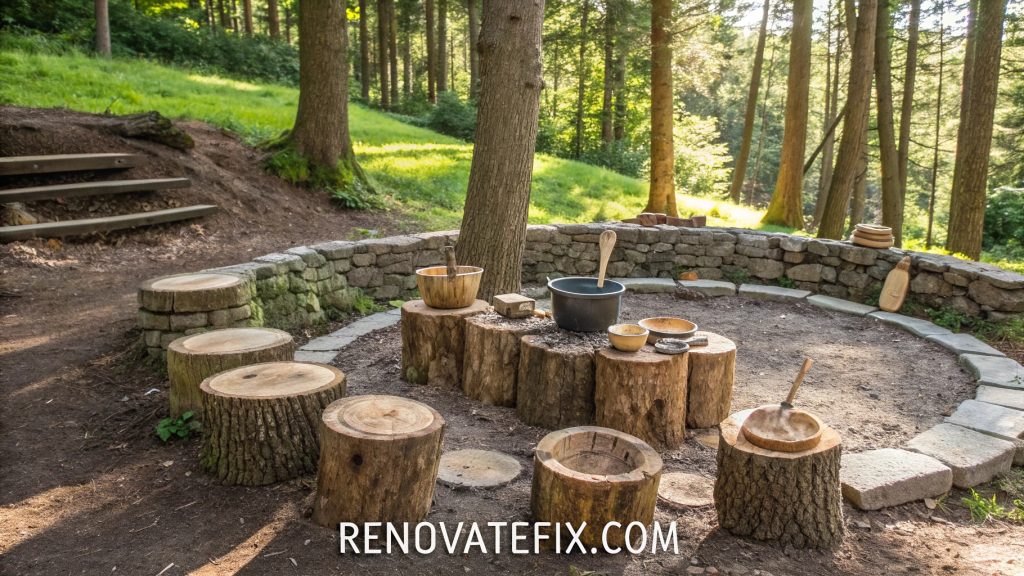
Position these solid wood platforms around a central mixing area lined with stones, fostering social interaction while providing sturdy, weatherproof stations that blend seamlessly into natural surroundings.
9. Fairy Garden Mud Kitchen
Scale down a standard cooking station with miniature utensils, tiny pots, and delicate details that appeal to children fascinated by fairy lore and small-world play scenarios.
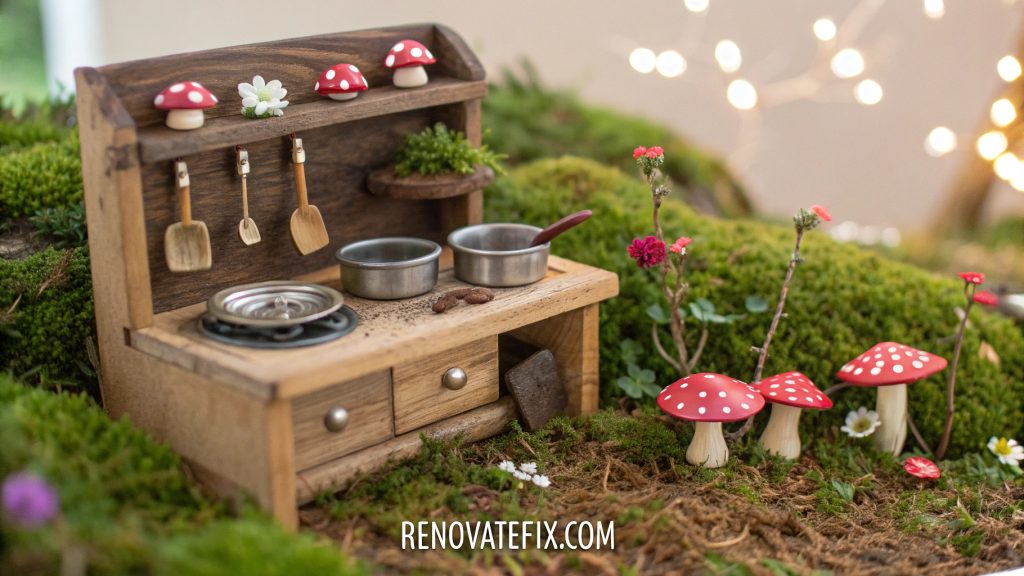
Surround with moss, small flowering plants, and perhaps a few whimsical figurines to spark stories about cooking feasts for woodland creatures living beneath toadstools and leaves.
10. Dual-Level Mud Kitchen
Build a two-tiered food preparation area with a lower counter for toddlers and a higher work surface for older children, allowing mixed-age siblings to play together comfortably at their own heights.
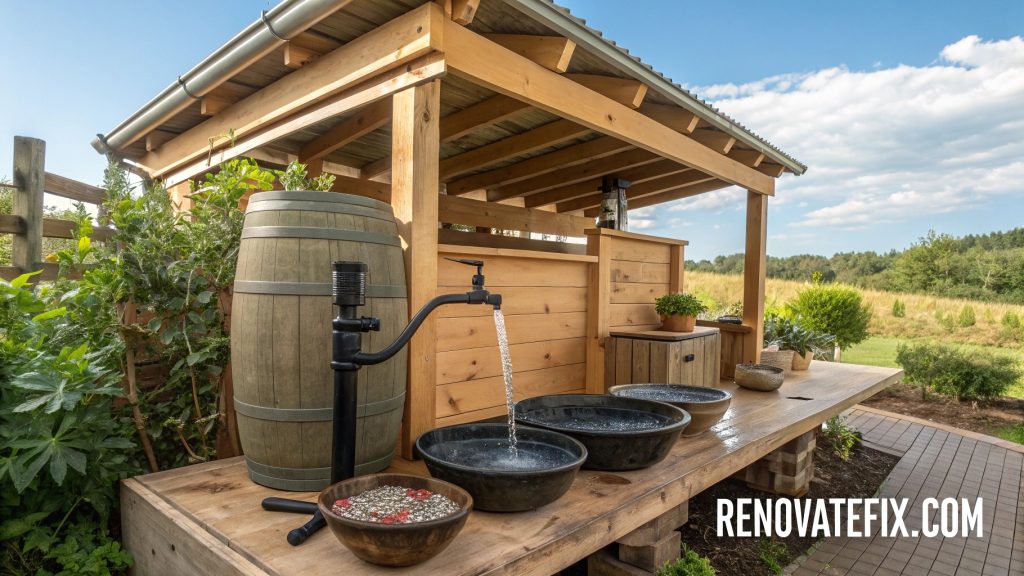
This thoughtful design accommodates different developmental stages, preventing frustration while encouraging family bonding during outdoor cooking sessions regardless of age or physical ability.
11. Rainwater Collection Mud Kitchen
Install a simple gutter system leading to a barrel or container that captures rainfall, creating a sustainable water source for mud mixing activities throughout dry spells.

Connect this reservoir to a basic pump or spigot that children can operate independently, learning about water conservation while having access to this essential ingredient for their earth-based culinary experiments.
12. Seasonal Nature Bar Mud Kitchen
Dedicate a special shelf or series of containers within your cooking station for displaying seasonal natural materials that change throughout the year – spring flowers, summer berries, autumn leaves, or winter pine cones.
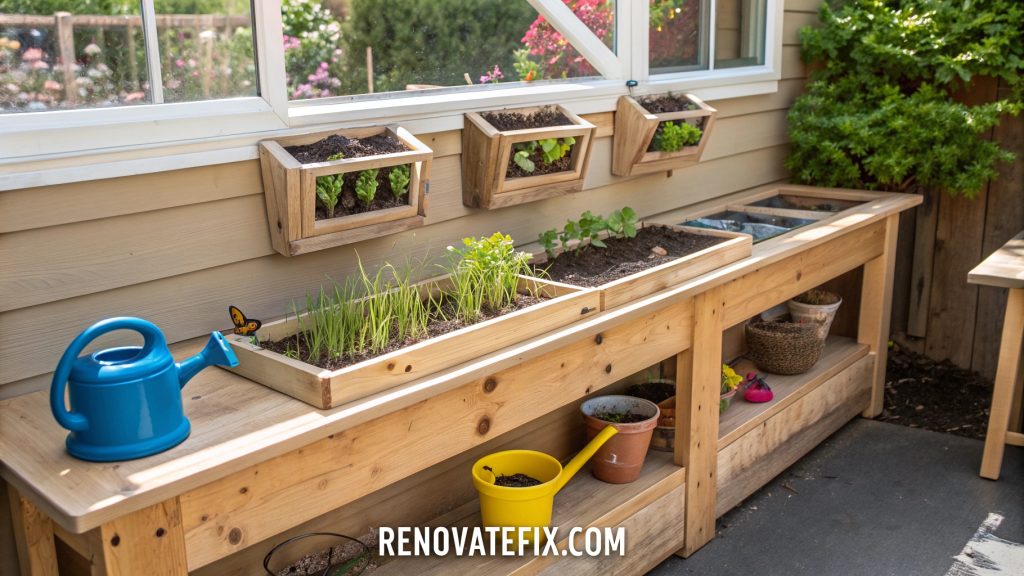
This evolving collection encourages observation of seasonal changes while providing fresh inspiration for creative mud recipes that reflect the natural world’s annual cycles.
13. Window Box Mud Kitchen
Mount shallow troughs filled with soil along the backsplash area of your cooking station where children can plant quick-growing seeds like grass, cress, or marigolds, integrating real gardening into pretend cooking scenarios.
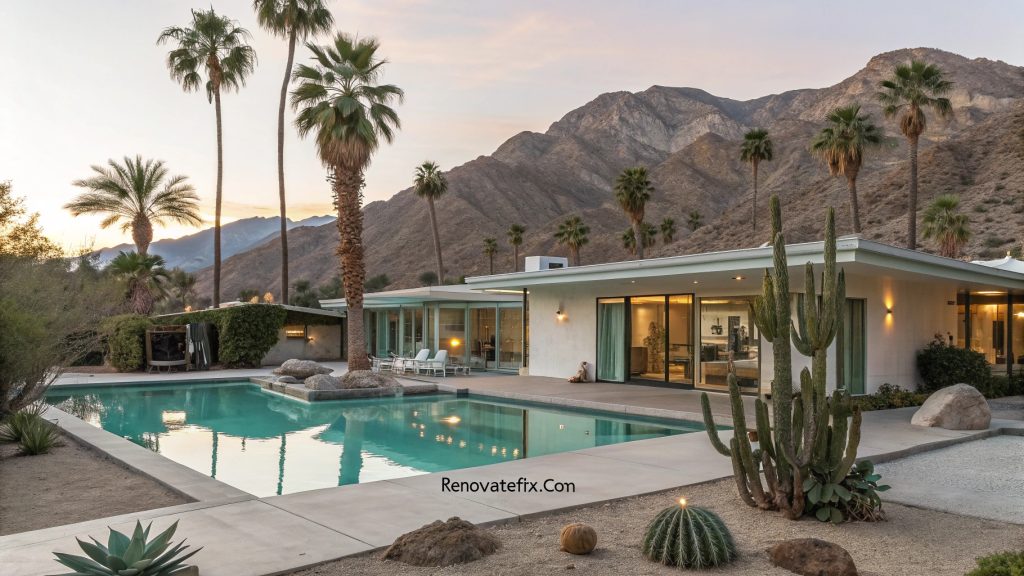
These living additions provide texture, color, and authentic plant materials for harvesting during play while teaching basic cultivation skills in a child-sized, accessible format.
14. Bakery-Style Mud Kitchen
Focus your design around baking rather than stovetop cooking by including cupcake tins, pie plates, and cookie cutters alongside a flat “oven” shelf where finished clay creations can “bake” in the sun.
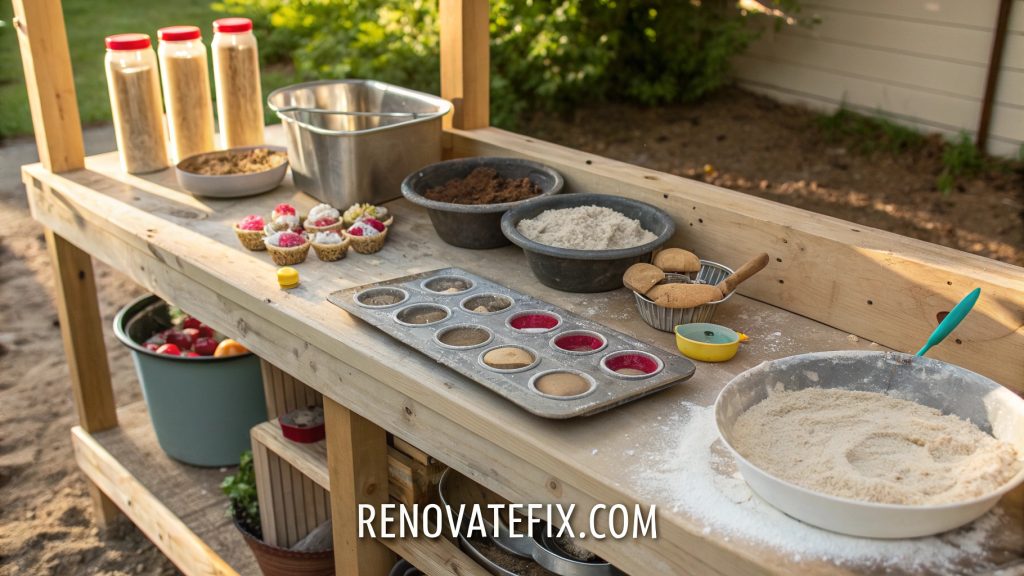
Add a rolling pin, measuring cups, and perhaps a dedicated kneading surface where sandy soil can be mixed with water to achieve just the right consistency for molding.
15. Market Stall Mud Kitchen
Extend the play value of your cooking area by adding a small counter or window where children can “sell” their mud creations to willing customers (parents, siblings, or stuffed animals).
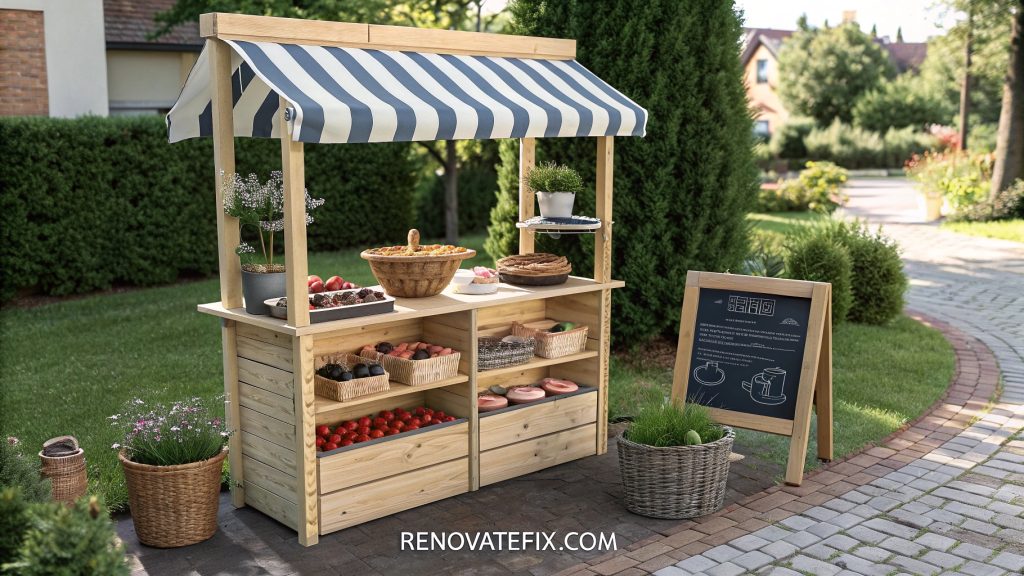
Complete this commerce-themed addition with a simple awning, display shelves for finished goods, and perhaps small baskets for gathering and presenting nature’s ingredients before the cooking process begins.
5 More Innovative Mud Kitchen Ideas
16. Brick Oven Mud Kitchen
Construct a curved alcove from heat-safe bricks or stones that mimics a wood-fired oven, providing an authentic baking experience where mud pies can be slid inside on wooden paddles just like artisanal bread.
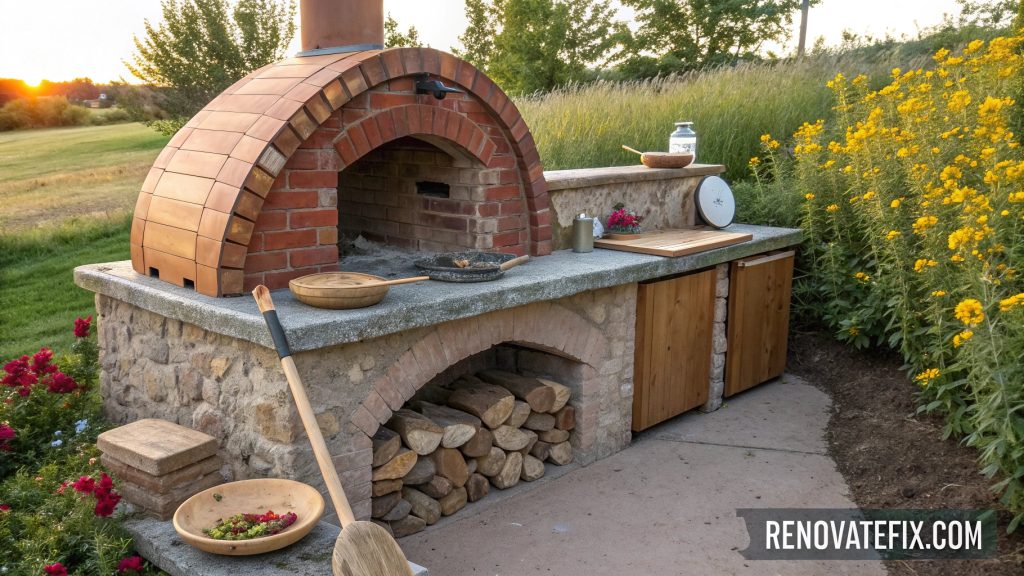
Arrange these sturdy materials in a semicircle against an existing wall, creating a durable cooking feature that withstands weather while sparking interest in historical cooking methods.
17. Food Truck Mud Kitchen
Repurpose an old wagon, cart, or plastic playhouse into a mobile mud food truck complete with serving window, menu board, and steering wheel for imaginative journeys between cooking sessions.
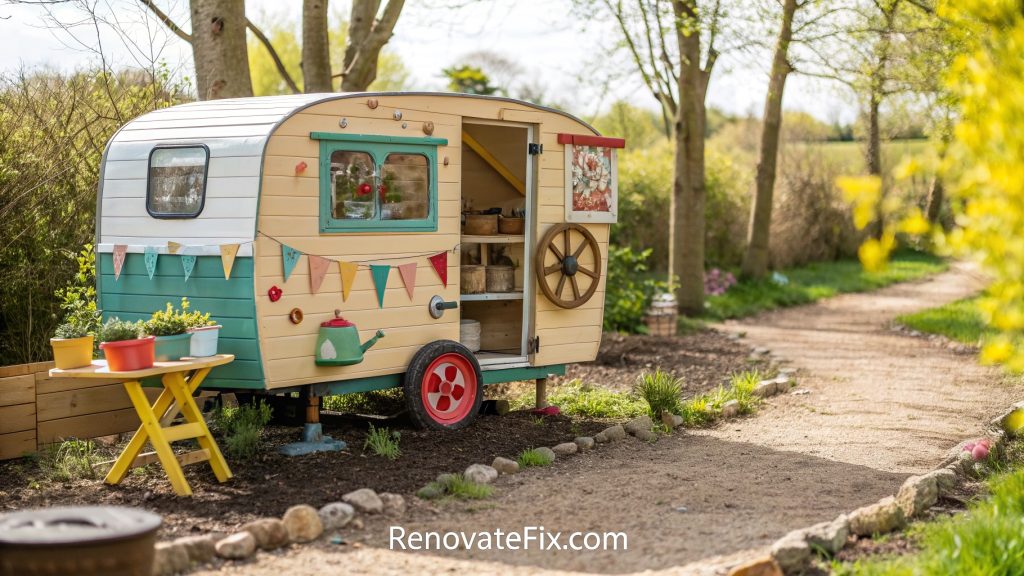
Paint with bright colors, add wheels (functional or decorative), and create signage announcing specialties like “Mud Burger Palace” or “Daisy Soup Kitchen” to enhance roleplay scenarios.
18. Woodland Workshop Mud Kitchen
Nestle your cooking station among trees, using living branches as partial framework and incorporating fallen logs as natural countertops where moss and mushrooms might eventually grow.
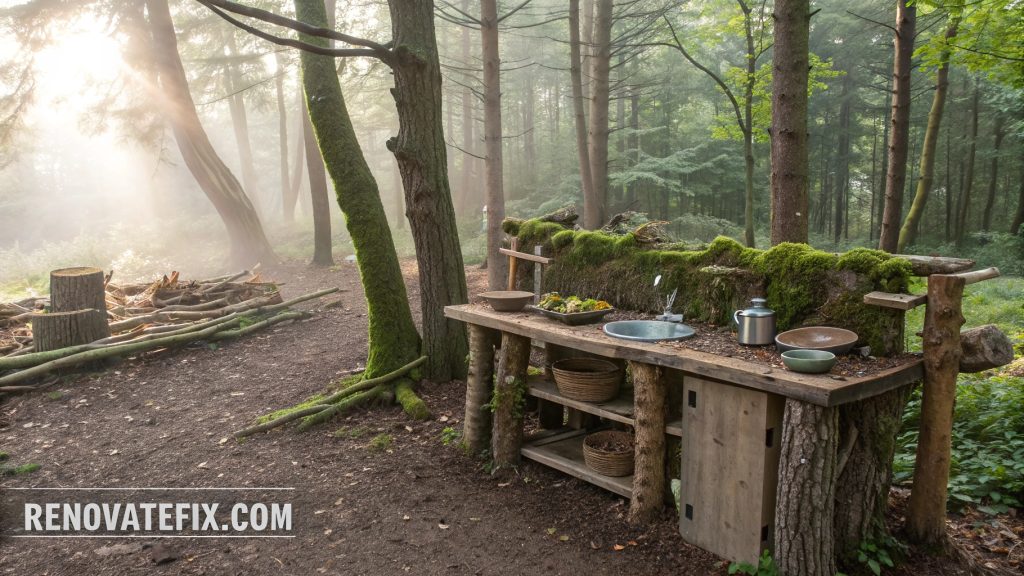
Keep construction minimal, allowing forest elements to remain dominant while providing just enough structure for mixing, pouring, and arranging forest findings into nature-inspired concoctions.
Conclusion
Mud kitchens offer an exceptional opportunity for children to engage with nature while developing crucial skills in creativity, problem-solving, and sensory exploration.
These twenty ideas demonstrate the versatility of outdoor play spaces, proving that meaningful learning environments don’t require expensive materials or complicated setups.
Whether you choose to build a simple pallet construction or develop a more elaborate multi-feature play station, the real magic happens when children are given freedom to experiment with natural elements in an open-ended way.
By providing these outdoor cooking spaces, we invite young minds to connect with the natural world, develop rich imaginative scenarios, and experience the simple joy of messy play.
Your mud kitchen creation will likely become a cherished space where childhood memories are formed through hands-on discovery and uninhibited creativity.




